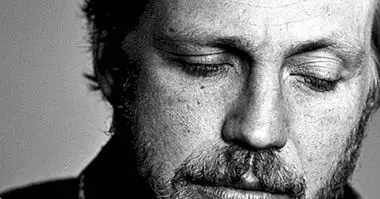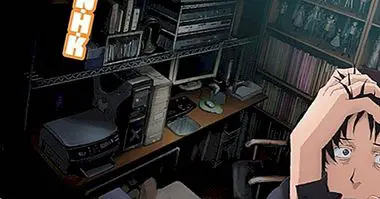Suicidal thoughts: causes, symptoms and therapy
AND There are a lot of situations and contexts that can cause us great pain : the death of loved ones, the experience of sexual, physical and psychological abuse, the feeling of guilt before the responsibility (real or not) of a fact such as a traffic accident, losing everything you have fought for, fighting in a war or the prospect of enduring a chronic or prolonged illness or incapacitating disorder (physical and mental) are some examples.
In some cases, the pain suffered is such that the person is not able to cope, feeling no control over his life and coming to believe that he can not do anything to improve his situation. In short, they lose hope.
In this context, it is not uncommon to think of a definitive solution to end such suffering, and the idea of ending one's life may arise. In other words, suicidal thoughts would appear .
- Related article: "Suicides: data, statistics and associated disorders"
Suicidal thoughts: what are they?
They are considered suicidal thoughts all those thoughts that an individual has about intentionally and intentionally taking his life . These thoughts can go from the mere desire to die to the active realization of concrete plans for the start-up of autolysis. The latter, in which the subject has elaborated the how, where and when, is the most dangerous and prone to perform the act.
Although the thoughts and desires of death can appear in a punctual occasion, in general when one talks about suicidal ideation or suicidal thoughts it is usually made reference to a pattern of recurrent thought in which the desire to die appears. A purely cognitive form may appear, although the most usual thing is that a certain desire or desire at emotional or motivational level is produced.
Most suicidal thoughts are experienced in times of intense pain and emotional suffering. The individual feels that regardless of what he does he will not be able to modify the reason for his suffering. He does not feel able to find the solution, but he feels helpless and in the absence of any control. The person with these thoughts loses tends to suffer a deep sense of hopelessness. Usually the underlying idea, the goal that is sought in itself with suicidal ideation is not to end one's life in itself , but end with this state of pain and helplessness.
Apart from this there are other types of suicidal thoughts that are linked more to the attempt to harm other people or achieve specific objectives. For example, in some cases one can arrive at the thought of using one's own death or suicide attempt in an instrumental way to achieve a good for oneself (such as the attention of others or in the case of vicarious violence) or beings loved ones (for example, collecting insurance) or to bring guilt and suffering to someone who is considered responsible for the pain of the individual.
Possible causes and risk factors
The causes of the presence of suicidal thoughts can be many and very different, depending on the specific case . As it has been indicated as a general rule, this type of thoughts usually happen after the experience or notification of some painful event or a loss in which deep feelings of pain, guilt and / or shame appear that are beyond the control of the individual and add up in a state of despair in which they do not find any possible solution.
The presence of abuse, loss of loved ones (either by death or rupture) or faculties or an anxious situation from which it is not possible to escape are usually the most frequent triggers. Examples would be the experience of a rape, prolonged isolation, physical incapacitation, having caused and / or survived an accident, continued bullying, bankruptcy, the diagnosis of diseases such as cancer, dementias or HIV or the suffering from some mental disorders that occur with psychic suffering.
Neurobiology of the person with suicidal ideation
At a biological level, the presence of a decrease in the level of serotonin in the brain of people with this type of suicidal thoughts has been observed, focusing much of the pharmacological treatments on increasing this level. Other hormones such as dopamine and norepinephrine are also of great importance, as their absence or presence contributes to depressive and anxious states that can lead to attempts at autolysis.
They are risk factors for passing from thought to act, such as belonging to the masculine gender, having an advanced age (they are usually more frequent after the age of forty), having had suicide attempts in the past or having a loved one has died in this way, the suffering of a mental disorder that clouds or biases the ability to judge, the existence of addictions to psychoactive substances, chronic medical problems and high impulsivity.
The isolation and absence of social support are also very important factors that can seriously damage the mental state of individuals (the presence of social support being an important protective factor).
Psychological evaluation and diagnosis
Although the presence of suicidal ideation does not have to involve a real attempt to kill oneself, it is a very important risk factor that must be treated urgently . In fact, at the therapeutic level, it is essential to assess the existence of suicidal thoughts and, if so, they become the first therapeutic objective.
When evaluating the mental state of the subject, it is necessary to do it calmly and directly, whether or not risk factors are present. If the suicidal thoughts have not been presented, asking about the subject will not induce it, while in the affirmative case the approach with which the case will be taken should focus on its existence. When evaluating the answers, it must be taken into account that the individual may not want to directly explain their thoughts.
Attitudes that try to minimize the risk or the importance of this type of ideation may be trying to hide the true thoughts about it. Sudden states of calm can also be indicative after a deep agitation, being a possible warning that the individual has taken the decision to take action.
The presence or absence of suicidal thoughts should be explored, the origin of such ideas, their degree of activity and elaboration and the existence or not of a plan to carry out. How, when and why are necessary questions and that allow you to get an idea of the seriousness of the situation. The greater the planning and specification of the answers, the greater the risk that the thought will be put into practice.
Treatment: how to act in a case of possible suicide
In cases of suicidal ideation, rapid treatment is necessary that allows to act effectively on the core of the problem. It must be borne in mind that, contrary to the widespread myth, in most cases the person who thinks about committing suicide and believes that there are possibilities to end up opting for that option, warns or warns friends or family.
In the event that suicide is imminent and the patient's safety may be seriously compromised, immediate hospital admission is recommended so that it can be controlled and appropriate treatment can be applied.
Psychopharmacology
Although the presence of suicidal thoughts does not necessarily imply the existence of a mental disorder, because they usually appear in contexts in which there is associated depressive symptomatology as a general rule, they tend to use psychotropic drugs, in the form of different types of antidepressants. Specifically, one of the most common subtypes in these cases are tricyclic antidepressants, which in the presence of atypical depression or suicide attempts have shown greater efficacy than other types of antidepressants.
However, these drugs generally take several weeks to take effect. That is why initially the treatment of choice goes through the application of anxiolytic drugs , reducing anxiety and tension that usually induce suicidal thoughts.
On the other hand, we must be clear that the context has a very important role in suicidal ideation. That is why psychotropic drugs can be a useful patch, but not a definitive solution. It is necessary to intervene on the social circles through which the person moves, as well as on the material means with which he lives.
Associated mental disorders
In cases in which suicidal thoughts are linked to mental disorders, they frequently appear in patients with bipolar disorder (it is common for thought to appear in the depressive phase while the attempt at autolysis is usually more typical of manic phases). After this, which is the disorder with the highest number of suicide attempts, other disorders where suicidal ideation appears with great frequency are substance addiction (especially alcohol), major depression, schizophrenia and borderline personality disorder.
Another treatment that at the biological level has shown greater success in alleviating the depressive symptomatology associated with suicidal thoughts is electroconvulsive therapy. Although it is not yet known why, it has been shown to rapidly and effectively reduce depressive symptomatology in atypical, psychotic depressions and with attempts at autolysis. That is why it is used in cases where immediate action is required.
Psychological therapy
With regard to psychological treatment, taking into account the need for early and rapid intervention in severe cases, a treatment focused on the behavioral aspect is usually required in order to subsequently treat the cognitive aspects.
It is essential to help establish relevant and accessible objectives for the patient, graduating a series of steps that in the beginning can serve to diminish the interest in suicidal thoughts and to direct him to something he wants to achieve. The main objectives to be worked on will be the recognition and expression of suffering, the acceptance of the patient's feelings and emotions, redirecting the focus of attention and the negative thinking pattern towards other more effective alternatives.
Through behavioral techniques such as the gradual assignment of tasks, the control of environmental stimuli and behavioral experiments, the individual will be motivated to endure or diminish the state of internal tension.
On a more cognitive level, the descatastroficación carried out with prudence can help to fight the motive that has led the subject to wish his own death . Beck's cognitive therapy also allows you to fight against automatic negative thoughts. Problem-solving therapy, Rehm self-management therapy or social skills training can help to regain the feeling of control on the part of the subject. The use of dramatizations can be useful for the patient to feel relief by exposing the reason for their pain and work on their feelings.
Another useful therapy is dialectical behavioral therapy, specialized in aggressive and autolytic behaviors, which contributes to improving coping ability while demonstrating an acceptance of the patient's suffering.
The use of psychoactive substances such as alcohol or drugs can cause an exacerbation of symptoms , so that the control of consumption is a fundamental element to take into account. Especially if there is a previous abuse or addiction. However, in case of dependency, sudden withdrawal can cause the presence of an anxiety that can be dangerous, so that such withdrawal should be prescribed by a professional.
The presence of social support and a network that allows the individual to change their perspective of the facts or assume new challenges and roles is also important. Likewise, the surveillance of the mental and physical state of the individual and the fact that he does not remain isolated are protective elements that make autolysis difficult.
Bibliographic references:
- American Psychiatric Association. (2013). Diagnostic and Statistical Manual of Mental Disorders. Fifth edition. DSM-V. Masson, Barcelona.
- Appleby, L. (2000). Prevention of suicide in psychiatric patients. In: K Hawton, K van Heeringen (eds). The international handbook of suicide and attempted suicide. Chichester: Wiley & Sons Publishers.
- Harris, E.C. & Barraclough, B. (1997). Suicide as an outcome for mental disorders. A meta-analysis. Br J Psychiatry; 170: 205-28
- Santos, J.L. ; García, L.I. ; Calderón, M.A. ; Sanz, L.J .; de los Ríos, P .; Left, S .; Román, P .; Hernangómez, L .; Navas, E .; Thief, A and Álvarez-Cienfuegos, L. (2012). Clinical psychology. CEDE Preparation Manual PIR, 02. CEDE. Madrid.
- Thase, M. E. (1992). Long-term treatments of recurrent depressive disorders. J. Clin. Psychiatry; 53
- Welch, C.A. (2016). Electroconvulsive therapy In: Stern TA, Fava M, Wilens TE, Rosenbaum JF, eds. Massachusetts General Hospital Comprehensive Clinical Psychiatry. 2nd ed. Philadelphia, PA: Elsevier.



















